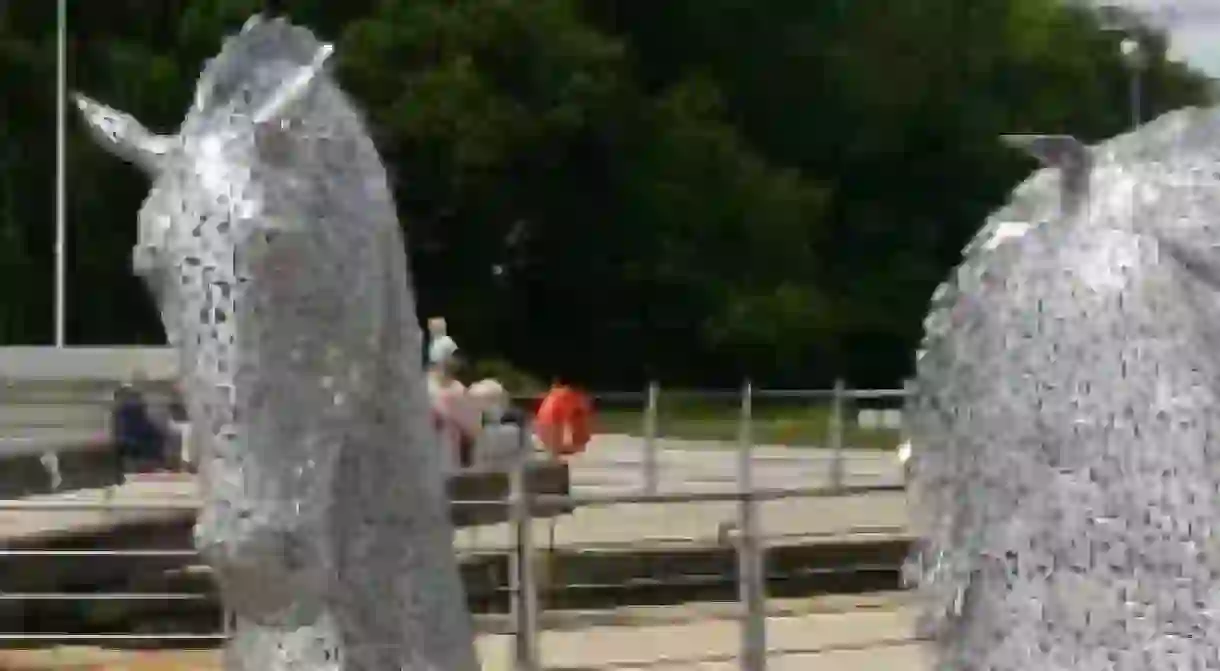Escape Edinburgh: Flee to Falkirk's Fringe

Take a day away and explore Scotland’s Central Belt, the hinterland between Edinburgh and Glasgow. An estimated three and a half million of Scotland’s five and a bit population live there. The most densely peopled area of Scotland might seem a strange place to escape humanity, however, with most rail journeys under an hour from Waverley, it is a rewarding region to uncover. So leave the capital and head into the heart of Scotland.

Princess Anne’s Kelpies
The forty minutes to Falkirk takes you out of the city, lying just off the M9 sit The Kelpies. Sculptor Andy Scott’s thirty metre high horses stand guardian over the Forth and Clyde Canal. With the mythological steeds possessing the power of a hundred horses, they are both a retrospective epitaph for lost industry and new defenders of the proudly resurgent Scottish nation. At Helix Park, with sculptures to discover and play parks to pound, they are a great day out for any age. The Kelpies, opened in April 2015 by Princess Anne, are a truly majestic feat of ninety day engineering. Their setting, beneath the distant heights of Scotland’s lowland peaks, and above the waterway that reflects the high horses in its depths, have a transcendental beauty by day or neon lit night. The Kelpies Helix Park Grangemouth Falkirk FK2 9EE 01324 590900

The Falkirk Wheel of Fortune
Hop aboard the pink bus or hire a bike for the thirty minute ride from The Kelpies to the famous Falkirk Wheel. The Wheel is an ingenious feat of civic engineering that solves a problem that keeps everyone awake at night: how to connect two canals when one is on the hill and another 100ft below. The thirty five metre solution is a rotating boat lift that swings like a clock face pendulum as the two arms extend out over the loch. It is an amusing pastime to watch a canal boat, like the Govan Seagull, suspended in the air as it descends upon the scone eating scots in the cafeteria. The bridge blocks the sun and almost crushes the spectators beneath the might of its arm. Meanwhile, tourists attempt to predict the path of the Wheel and unlock the science with a range of histrionic arm waving amidst a surfeit of collective ignorance. Archimedes can rest safely, there is no threat here, one man merely remarks on the gender of the tourist trip sailor: “female drivers…” The Falkirk Wheel Lime Rd Tamfourhill Falkirk FK1 4RS 0870 050 0208

The Falkirk Water Wheel
The Wheel, fully functioning since 2002 is an instance of civic pride manifested in infrastructure investment. The council have cultivated a real destination. Not only can you mount the Wheel for spectacular views of Falkirk and the Forth (though the pricing is steep at £8.95 for adults), there is a water park with the caveat “you are likely to get wet whilst playing at The Water Park, so make sure you wear the correct clothing.” As one parent decries “stop attacking me with your wetness”, the mounted machine water guns are worryingly militant for any pro-British referendum voters. The Visitors Centre staff apologise for the sold out boat tour with the addition of “wait two weeks, when the English get here”, but everybody is happy. This is about as close to a beach feel within the Belt. Everyone seems remarkably at ease in the baking twenty degree sunshine. The Falkirk Wheel Lime Rd Tamfourhill Falkirk FK1 4RS 0870 050 0208

The Antonine Wall
Nearby is the Antonine Wall, lurking a mile walk above the site at Rough Castle Roman Fort. The Antonine Wall was the northernmost extremity of the Roman Empire after Hadrian’s successor, Antonine, decided to extend his territory northwards into Scotland. However, after a single generation, these southern softies retreated to the saunas and baths of Hadrian’s Wall. All that is left of the legions is a rather scantily clad Roman customs official who surveys the rampart in swimming trunks, red cape and helmet. The problem with the Wall is that it is a misnomer, it is more of a grassy bank with a big ditch. Not the most impressive spectacle, but after weeks watching live performance, it is a perfect place to settle with a second hand copy of Scott and listen to the trickle of the stream.
The Firth of the Forth
The fifth and final is the Firth on the Forth. From one of Scotland’s oldest World Heritage Sights to its newest. A fifteen minute train ride out of Waverley lies Queensferry (Dalmeny or North Queensferry stations). Either side of the Forth gives exceptional views of this Victorian icon: the Forth Bridge, celebrating its one hundred and twenty fifth anniversary this year. Celebrating in style, with accession to the UNESCO elite, hop off at Dalmeny for the picture postcard photo of the bridge, but North Queensferry allows a crossing and views from underneath the riveting structure. A new proposal for a Visitors Centre will allow a 360° viewing experience from on top of the freshly painted red lips of the bridge. Currently a twee village that collapses into the Forth, now is the time to get to North Queensferry before the buses descend and everything becomes busier. Firth of Forth
By Rory McInnes-Gibbons













